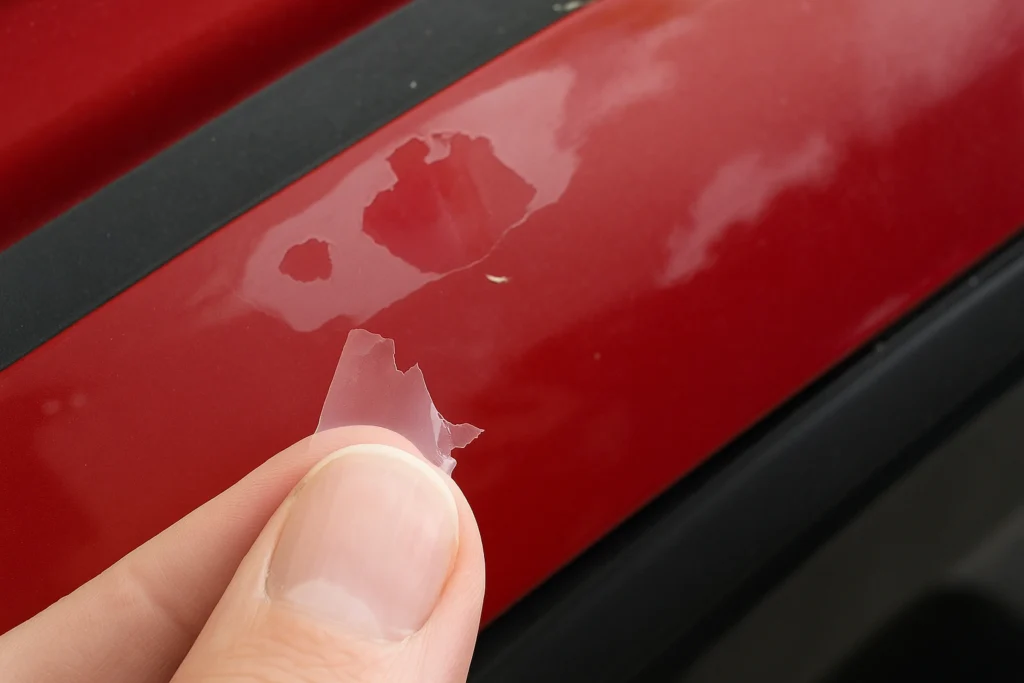Introduction
If you’ve noticed your vinyl wrap lifting or peeling, you’re not alone. Many USA car owners face this issue after months of daily driving and exposure to the elements. The good news is that learning how to fix peeling edges on a wrap is easier than you think. Whether it’s a simple DIY touch-up or knowing when to turn to a professional, addressing peeling early will keep your wrap looking sharp and extend its lifespan.
Key Takeaways
- Peeling edges are often caused by improper installation, harsh weather, or lack of maintenance.
- Small wrap lifts can sometimes be repaired at home, but larger sections require professional attention.
- Preventive care and regular vinyl wrap maintenance are essential to avoid recurring peeling.
- Choosing the right finish and quality material reduces long-term wrap problems.
- VinylWrapRo provides expert installation and repair support across the USA.

Vinyl Wrap FAQs (People Also Ask)
To fix peeling edges on a car wrap, gently reheat the area with a heat gun, press the vinyl back down, and seal it with edge tape or primer. This works best for small, localized lifts. For larger sections, it’s recommended to visit a professional installer to avoid further damage. If you’re deciding between a home repair or professional help, check out our guide on DIY vs professional car wrap installation for detailed pros and cons.
Vinyl wrap edges usually peel due to poor installation, lack of proper surface prep, or exposure to heat and moisture. Overstretching the material during installation can also weaken adhesion. Environmental factors, like strong sun exposure, can accelerate edge lifting. For comparison, some finishes such as chrome are more prone to peeling than others, learn more in Gloss vs Matte vs Satin vs Chrome: Which Finish Should You Choose?.
Yes, you can re-stick a vinyl wrap if the peeling area is small and clean. Using a heat gun and adhesive promoter helps the wrap bond again. However, once dirt or moisture has gotten under the film, adhesion becomes weak, and a full replacement may be needed. Curious about the material’s limits? See whether you can reuse a vinyl wrap after removal.
You can repair minor peeling at home with heat and pressure, but professional repair ensures longer-lasting results. DIY fixes work temporarily, but pros use edge sealers and certified adhesives designed for durability. For USA car fleets or high-value vehicles, working with experts like VinylWrapRo ensures the wrap’s longevity and protects your investment. Read more in our comparison of DIY vs professional car wrap installation.
Prevent peeling by ensuring proper installation, avoiding pressure washers on edges, and following a consistent vinyl wrap maintenance routine. Parking in shaded areas and hand washing with gentle products also extend wrap life. Choosing high-quality wrap films and a reputable installer like VinylWrapRo is the best way to minimize future peeling.
Ignoring peeling edges can lead to dirt and water getting underneath the vinyl, causing larger sections to fail. Over time, this may result in costly replacements instead of minor repairs. Fixing small problems early helps preserve both the look and protective function of your wrap. If you’re exploring replacement options, consider finishes and durability factors in our guide on Gloss vs Matte vs Satin vs Chrome.
Final Thoughts
Peeling edges on a vinyl wrap are a common issue, but they don’t have to compromise your vehicle’s look. By knowing how to fix peeling edges on a wrap, you can handle minor repairs at home and recognize when it’s time to consult a professional. For a deeper dive into full installation techniques, check out our Car Wrap Installation Process: Step-by-Step guide. You can also explore related topics like vinyl wrap maintenance to keep your wrap looking new.
For trusted wrap repairs and expert installation across the USA, visit VinylWrapRo.

